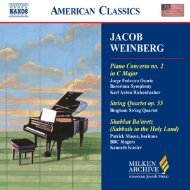Download Liner Notes PDF - Milken Archive of Jewish Music
Download Liner Notes PDF - Milken Archive of Jewish Music
Download Liner Notes PDF - Milken Archive of Jewish Music
You also want an ePaper? Increase the reach of your titles
YUMPU automatically turns print PDFs into web optimized ePapers that Google loves.
composers—who discovered the artistic potential <strong>of</strong><br />
ethnic roots—exploited and incorporated folk themes<br />
and tunes from their respective ethnic and regional<br />
traditions, not only in programmatic tone poems,<br />
but also <strong>of</strong>ten in the framework <strong>of</strong> standard classical<br />
forms such as symphonies, sonatas, concertos, and<br />
string quartets. Secunda’s piece here <strong>of</strong>fers a pastiche<br />
<strong>of</strong> interwoven but transparently recognizable <strong>Jewish</strong><br />
melodies and motifs—mostly from Hebrew liturgy,<br />
but with some flavoring <strong>of</strong> <strong>Jewish</strong> secular sources<br />
outside the synagogue—within the context <strong>of</strong> one <strong>of</strong><br />
the most established intimate forms <strong>of</strong> Western art<br />
music: the four-movement string quartet. In terms<br />
especially <strong>of</strong> its formal structure (less so with respect<br />
to contrapuntal technique or texture), however,<br />
Secunda’s quartet looks even further back—to the<br />
18th century and Joseph Haydn’s conception <strong>of</strong> and<br />
predominance over the string quartet genre. It is<br />
almost as if Secunda were trying to imagine, in overall<br />
concept as well as in certain sections, how “Papa<br />
Haydn” might himself have handled an assignment<br />
to build a quartet around this same <strong>Jewish</strong> musical<br />
material—with some clairvoyance <strong>of</strong> late-Romantic<br />
and 20th-century clichés as well.<br />
This is not a programmatic work in the sense <strong>of</strong><br />
illustrating any literary or historical agenda. To the<br />
contrary, the preexisting melodies—whose sources<br />
range from High Holy Day and Three Festivals prayers<br />
to cantorial-type melismas to wedding bands—appear<br />
to have been selected arbitrarily. Their only connection<br />
to one another is their common provenance in the<br />
traditions <strong>of</strong> Ashkenazi Jewry in eastern Europe and in<br />
their transplanted stage in America. There are specific<br />
identifiable tunes with established liturgical functions,<br />
ubiquitous motifs from synagogue song in general<br />
and from biblical cantillation, and hints throughout<br />
at typical Ashkenazi patterns and modalities.<br />
The first movement begins with a resolute yet briefly<br />
meditative prologue, with successive pronouncements<br />
by each <strong>of</strong> the four instruments. This leads to the<br />
exploration and development <strong>of</strong> the two principal<br />
themes upon which the movement is based:<br />
a. A well-known quasi-congregational tune for<br />
certain passages <strong>of</strong> the hatzi kaddish prayer in its<br />
rendition as an introduction to the mussaf services<br />
specifically on Rosh Hashana and Yom Kippur.<br />
b. One <strong>of</strong> the principal chantlike motifs <strong>of</strong> the<br />
traditional Ashkenazi rendition <strong>of</strong> kiddush for the<br />
Three Festivals (Pesah, Shavuot, and Sukkot).<br />
As an affirmation <strong>of</strong> faith, kaddish—whose<br />
language, apart from a Hebrew response and the<br />
concluding sentence <strong>of</strong> its full form, is Aramaic—may<br />
be perceived as a Judaic doxology. It embodies the<br />
supreme acknowledgment <strong>of</strong> God’s unparalleled<br />
greatness—the ultimate expression <strong>of</strong> unqualified<br />
glorification, praise, and worship <strong>of</strong> God throughout<br />
all eternity. Among the several forms and versions <strong>of</strong><br />
its text, each with a distinct liturgical function, the<br />
hatzi kaddish (half kaddish) is recited to separate the<br />
sections <strong>of</strong> the liturgy in all services where a quorum<br />
<strong>of</strong> ten (minyan) is present. In one <strong>of</strong> those roles, the<br />
hatzi kaddish, in effect, introduces the mussaf—the<br />
additional service immediately following shaharit<br />
(the morning service) and the biblical readings <strong>of</strong> the<br />
Torah service on Sabbaths, High Holy Days, Festivals,<br />
and the New Month, thereby separating it from the<br />
immediately preceding liturgy.<br />
In all synagogues and services that follow the Ashkenazi<br />
rite (minhag Ashkenaz), there is—specifically attached<br />
to this mussaf kaddish on Rosh Hashana and Yom<br />
Kippur by requirement <strong>of</strong> canonized tradition—one <strong>of</strong><br />
the fixed, universally accepted, and exclusive melodic<br />
patterns <strong>of</strong> the so-called missinai tune family. This is<br />
21 8.559451
















